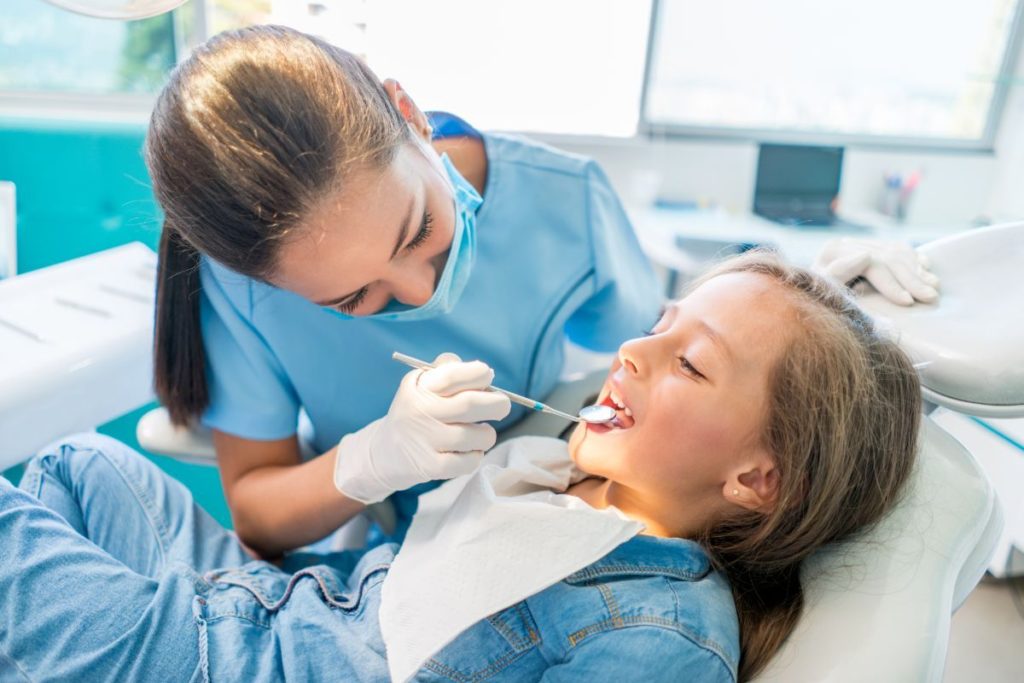Growing pains are a real thing, but you don’t want to pass off a misaligned jaw as a simple growth spurt! If your child is complaining about jaw pain, issues eating, or sleeping problems, it’s time to bring them to Sycamore Orthodontics & Pediatric Dentistry for a checkup. When it comes to recognizing and treating your child’s misaligned jaw, Dr. B and Dr. Sarah have you covered.
What is a misaligned jaw?
Ideally, when you close your mouth your upper and lower teeth should meet comfortably. When this doesn’t happen, you’re dealing with a misaligned jaw or a malocclusion. There are several types of malocclusion: overbite, underbite, crossbite, or open bite. If your child has a hard time eating, sleeping, breathing, or talking, they may have a misaligned jaw, and you should bring them in for an exam at Sycamore Orthodontics. Their malocclusion may be caused by:
- a mouth that is too small for the teeth
- upper jaw and lower jaws that are different sizes
- the early loss of baby teeth
- jaw injuries
- extended thumb sucking or pacifier use
- prolonged use of a bottle
- a tongue thrusting habit
What are the effects of a misaligned jaw?
Did you know that chewing your food can generate up to several hundred pounds of force per square inch? You use your jaws every time you eat, so if there’s a misalignment present, those powerful muscles won’t be able to bite down as easily. Over time, this can cause an imbalance or put significant pressure on specific teeth.
In an attempt to correct this, the jaw muscles may overcompensate and cause soreness. Severe jaw pain can have a knock-on effect, too. Eating may become uncomfortable, while normal speech, sleep, and even breathing patterns may be disrupted. Because the joint where the upper and lower jaw meets is so complex, improper functioning can also lead to chronic pain that occurs even when the jaw isn’t moving.
Here’s a handy example to help you visualize the way a misalignment has a ripple effect: imagine wearing a sneaker on one foot and a flip-flop on the other for an entire day. Your feet would certainly be sore by the end of the day, but your back and legs would be hurting, too! Being off balance would cause lingering aches and pains that would continue even after you took the shoes off. A bad bite works in a similar way, except there are no mismatched shoes you can remove! That means living with your symptoms every day or finding a way to successfully treat the problem.

How Sycamore Orthodontics Can Help
You may not always be able to prevent a misaligned bite, but there are definitely steps you can take to correct one! When you schedule your free consultation with Dr. B or Dr. Sarah, we’ll examine and assess your teeth and jaw. If treatment is recommended, you’ll receive a customized treatment plan based on your specific needs, lifestyle, and goals. This may include one or more of the following treatment options.
Braces or Invisalign
Braces tend to be the most common way to correct a malocclusion. We offer traditional metal braces, clear braces, and clear aligners. With braces treatment, brackets are affixed to the front surface of the teeth and connected with a flexible wire. The wire is regularly tightened throughout the treatment process, slowly moving the teeth and jaw into more optimal positions. We may also use elastic bands to apply pressure that will achieve better alignment.
Clear aligner therapy works a bit differently. These innovative systems use a series of customized trays to move the teeth instead of brackets and wires. The aligners are made from a special thermoplastic material and designed to fit snugly over the teeth. Since they’re removable and almost invisible, clear aligners offer a bit more flexibility than traditional braces. They also allow you to brush, floss, and eat as you normally would! Invisalign can be just as effective as braces at treating many of the most common orthodontic issues.
Once your treatment with braces or clear aligners is complete, you’ll be given a custom retainer. This is what will keep your newly straightened teeth in place, so it’s very important to wear your retainer as directed.
Upper Jaw Expander
Upper jaw expanders are an orthodontic appliance we can use to correct an underbite. The wire-frame device fits across the upper palate, and a special key is used to widen the expander a very small amount each night. Over time, this will widen the upper jaw and bring the bite into alignment.
Jaw Surgery
In rare instances, jaw surgery may be required to correct a misaligned bite. This is usually reserved for patients who are struggling to eat, sleep, or speak properly. The sooner we treat alignment issues, the better the chance of avoiding jaw surgery! If your child is showing any signs of a misaligned jaw, we encourage you to schedule them for an orthodontic evaluation with us as soon as possible. We can usually correct a child’s problems with alignment before they get serious enough to need surgery.
Benefits of Treatment
Correcting a misaligned bite will help relieve jaw pain, but treatment comes with other benefits, too! Straight teeth are easier to clean effectively, reducing the risk of tooth decay and cavities. They’re also less likely to chip or become loose. Eating will be pain-free again, and many patients find that it’s easier to sleep and speak properly. Our customized treatments will give you a smile that feels good, looks great, and functions perfectly!

Sycamore Orthodontics & Pediatric Dentistry: Your Choice for a Beautiful Smile
At Sycamore Orthodontics & Pediatric Dentistry, we’re your one-stop shop for all your smile needs. From your child’s first pediatric dentist visit to braces, Dr. B and Dr. Sarah are here for you. If you’re ready to get started, contact our office in Sycamore to schedule your child’s first appointment!
